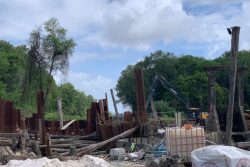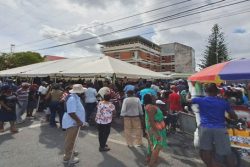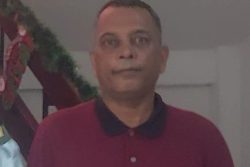It’s not on the main road, so you can drive by it every day and not know it’s there, as thousands do. It’s in West Demerara, and I passed it myself many times on the way to and from Parika, totally unaware that just about 200 yards from the main road is a museum housing the most impressive collection of Guyana memorabilia that you will ever encounter. It’s in area known as Kastev in the village of Meten-Meer-Zorg and descriptions can never do justice to the place – you have to see it to believe it. Indeed, the story behind it is as enthralling as the museum itself.
It centres around Gary Serrao, a Georgetown boy who became a chemical engineer in London, and who began collecting Guyanese artifacts while living outside his homeland for 20 years. “I lived away, but I was always homesick,” said Gary. “It never went away, and I began buying these items here and there.”
 He collected anything and everything related to Guyana, once it was in good condition, and by the time he retired from his job at British Gas to return to Guyana in 1993, the collection was enough to fill a 20ft container. He packed it in cardboard boxes and shipped it home.
He collected anything and everything related to Guyana, once it was in good condition, and by the time he retired from his job at British Gas to return to Guyana in 1993, the collection was enough to fill a 20ft container. He packed it in cardboard boxes and shipped it home.
Gary and his wife Shaimoon (she’s from Leonora), married for 17 years, had actually had plans for an eco-tourism business on the Essequibo River, but when that venture failed, wiping out most of their savings, friends who had seen his collection urged him to create an exhibition in his home at Kastev. In a process taking three years he added two floors to the dwelling for the display, and the Guyanese Heritage Museum was launched in 1999.
The collection on display today is simply staggering. In its span, it goes way beyond the traditional museum items – stamps; coins, books; maps; documents; etc. Through the items Gary has collected, this display of thousands of pieces is actually a compendium of life in Guyana going back to the 1800s. There are utensils, machinery, coins, books, weapons, drawings, lamps, jewellery, toys, earthenware jugs – literally everything once used or owned in this culture.
In tours operating daily from 10 a.m. to 5 p.m. visitors to the Museum are surrounded by this massive collection which has essentially taken over two floors of the house. The items hang on walls, on ceilings and in cabinets, or sit in showcases with neat descriptions.
It would take pages to list them all; many are in mint condition. Almost every conceivable item from early life in Guyana is there, from the elaborately decorated porcelain chamber pots, to the device used to light gas-burning street lamps in Georgetown. There’s an old mechanical calculator; coal-pot irons; the soft-drink bottles with the marble stopper; clippings and photographs of our early citizens; a huge collection of the beautiful imported cobalt blue glass bottles in every conceivable shape.
There are a number of significant items: he has an original 1633 map showing Guyana as part of the northern area of South America in an area then known as “Caribana”; you can see the 16th-century glass beads, used by European traders, as “the early money of Guyana”; there is a 1620 Shaft & Globe bottle, extremely rare, worth thousands of dollars; there is a book collection, a stamp collection, and an extensive display of scores of coins; there is an 1838 map of Hadfield Street, drawn by Joseph Hadfield the very man after whom the street is named.
The complexity and range of these items actually is a result of Gary ‘s obsessive devotion to his homeland while living outside it for 20 years; the psychological basis of that is fascinating to contemplate. Essentially a joyous man, full of humour, Gary plays down the motivation, but it has clearly been a fundamental part of the man, and he has continued to add to the collection since returning to Guyana.
What is sitting there today at Kastev on the West Coast is a powerful testimony to Guyanese culture. Groups of school children have visited the place, but more of us should see it. It is as much entertainment (Gary is a jocular tour guide) as it is cultural experience. The collection is so vast that an effort to do an inventory in 1999 had to be abandoned; there were too many pieces.
After a tour through the building, one is struck by the complexity and detail of Guyanese life it represents, but there is an equally strong wonderment at the notion of this man enthralled by his culture. He may not see it that way, but it has truly been a devotion. What was motivating him this way in far off London, for 20 years, never fading, never stopping? It’s an intriguing thought.
In a time when we hear so many complaints about the long list of developments or improvements that government or big business should be generating, one is always impressed to find something appealing or beneficial to a society that was achieved by one individual on a mission. Everywhere I’ve lived, I’ve seen these unique people who almost single-handedly manage to create something that wouldn’t exist without them.
Sometimes it’s a tradition, like the Canadian craftsman in a small town in Ontario who restores old violins in a little back-o-wall place for the sheer joy of it. Sometimes it’s a technique, like Carey Hurlstone in Cayman who makes beautiful glittering one-of-a-kind knives from old metal files. Sometimes it’s an attitude, as in the case of Syeada Manbodh here who somehow continually finds the time and energy to help animals in distress purely on her own volition.
They are special people making significant contributions to their culture, almost completely on their own. Mister Serrao is in that mould.
In a well-developed country an effort such as his would attract an operating subsidy from either Government or big business. It would be on the “must see” list of local attractions; regional airline magazines would do features on it. Perhaps, in time to come, as Guyana develops, that will come to pass. In the meantime, although not able to promote and advertise the Museum, Gary and his wife remain positive. “I believe we should be grateful to those who came before us, and that’s what the Museum is about. I will keep it going as long as I’m alive, and would hope that future generations take care of it.”
It is a riveting piece of Guyana; go and see for yourself. Call 275-0028.




